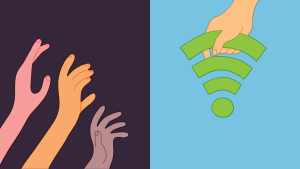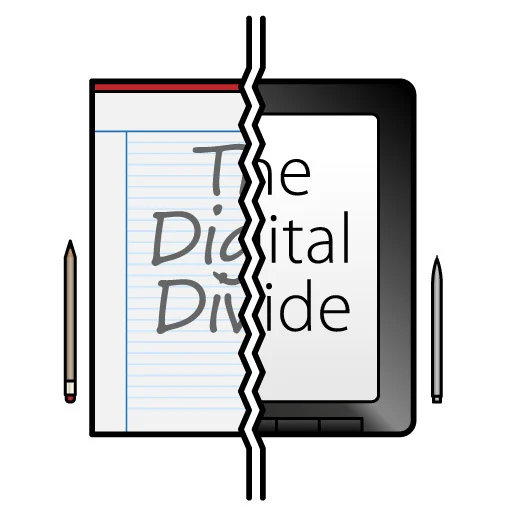The digital divide alludes to the unequal distribution of technology and internet connectivity. It describes the divide between those with access to reasonably priced, dependable internet service (as well as the knowledge and tools required to make the most of that access) and those without.
The phrase ‘Digital Divide’ first appeared in the late 20th century to distinguish between those with and without smartphones.

What is Digital Divide?
Today, it describes the distinction between those who can access the Internet (as well as other digital contact methods) and those who do not.
Rural populations are much more likely to be shut off from digital technologies than city dwellers, a problem in many nations.
Additionally, regions and countries are divided. Between males and women, it also exists: In 2021, 62% of men worldwide used the Internet, compared to 57% of women, a difference that has been closing over the previous ten years.
For people, companies, and communities alike, technology has the potential to produce substantial advantages and opportunities.
However, inequality can be exacerbated when access to technology is unequally spread. People with access to technology may gain chances for social engagement and community connections as more and more social interactions move online than those without such privilege.
For Instance, the coronavirus pandemic has highlighted the disparities in digital coverage in the U.S., particularly for children who must attend school online and those who live in less affluent areas where it has been challenging to schedule vaccination appointments.
For many people, the Internet has replaced other informational sources as their primary source of schooling, employment, healthcare, and social connections.
However, people with access to the Internet or other forms of technology might have a different entrance to knowledge and tools than those who do.
The information gap between those who have access to technology and those who do not could consequently widen.
In addition, unequal access to technology can result in fewer chances for individuals and communities to succeed economically.
People who need access to technology may need help to participate in the digital economy or take advantage of new job opportunities that call for digital skills because so many jobs and businesses now depend on it.
For those left behind, this may result in lower wages and lessened economic mobility. Now onto the next, what are the causes of the Digital Divide?
What Causes Digital Divide?
Technology has significantly changed over the past few years and will likely continue to advance and improve modern living.
However, there are several cases of Digital Divide globally. These issues include the high cost of Internet-connected devices and services, which prevents low-income people from using them;
Lack of knowledge and skills required to use the required instruments and technologies effectively and the challenge of putting in place the infrastructures necessary to promote the adoption of ICTs in specific regions.
It’s critical to comprehend the fundamental causes of these inequalities before attempting to address the increasing issue.
Having a solid foundation will help close the technology gap and provide people and families with chances that everyone should have.
The most significant contributor to the digital gap is the urban-rural divide. Several interrelated variables cause the digital divide. They include:
Age-Related Factors
Every new generation has grown up in a digital and connected environment. Children, teenagers, and young people under the age of thirty rarely refrain from using the Internet or other forms of technology or do not have access to them.
However, statistics for those over 65 indicate that 44% don’t have access to or don’t use the internet. The leading causes are a need for more knowledge about its advantages and applications and living choices that do not call for connectivity.
Socioeconomic Factors
Access to technology and the Internet is more widespread among those with more money. Those with better education levels undoubtedly know more about its uses and advantages.
The digital gap mirrors the global divisions brought on by social, economic, and educational factors. All socioeconomic variables have an innate connection to these gaps.
Accessibility issues only widen socioeconomic divides and disparities on a general level.
Geographic Causes
Even though the Internet is everywhere these days, several places in the U.S. and around the globe still need more high-speed access.
Urban areas are completely covered. Almost all neighborhoods have easy access. However, digital services are much less likely to be available to all residents in rural regions. This issue requires solutions addressing accessibility, geographic, and budgetary constraints.
Language, Culture, and Race
Unfortunately, many problems with access to technology and the Internet listed above are based on racial, cultural, and linguistic differences.
Once more, this corresponds to the majority of disparities, including wage disparity, access to high-quality healthcare and education, and even environmental factors that may affect health.
For instance, families who speak a language other than English at home, such as Spanish, are less likely to use online resources because many are not available in a language they can completely understand.
Types of Digital Divide

Usage gap
This means the inability to use ICTs effectively on a personal or business level. It also refers to the variation in skill levels that people hold.
For instance, people with more trouble using the Internet encounter an extra challenge when completing routine tasks (such as scheduling an online doctor’s appointment or using electronic banking, among other things).
There is a generational divide regarding the abilities required to use the Internet. It is also influenced by the caliber of education a person gets.
Individuals who are younger and more educated have more skills than older, less knowledgeable individuals.
Access gap
This has to do with some demographic groups needing access to ICTs as only some places have the public funding required to install infrastructures that facilitate Internet connection. It is the most prominent digital divide.
Also, not everyone has enough resources to pay for devices and services to connect, typically caused by socioeconomic inequality between people and various regions.
People in developing nations need more skills to use technology or the Internet effectively and have limited access to either.
Generation gap
The COVID-19 pandemic has further brought attention to the low digital skills that nearly half of the people between the ages of 65 and 74 have.
Additionally, those with lesser purchasing power or those who reside in rural areas typically see this gap widen.
Digital gender gap
In turn, fewer girls choose STEM jobs due to having less ICT access for women. Although both groups have access to the Internet in Spain, 62% of men and 57% of women use the Internet globally.
The gender disparity is more evident in some nations (like those in Africa or the Arab States).
The quality-of-use gap
This procedure is a little trickier. However, it alludes to the various ways people use the Internet and the reality that some people are much better than others at finding the information they require.
These skill sets and connectivity disparities reflect gender discrimination, wealth disparities, and access to schooling. The digital divide worsens these differences because it prevents many people from accessing the knowledge they need to improve their living circumstances.
Effects of the Digital Divide
Internet access was previously considered a luxury, and disparities in digital access were generally viewed in the same terms.
But there is a general understanding that technological exclusion is a social exclusion because it denies some citizens access to resources necessary for wealth accumulation.
Access issues for ICTs exacerbate disparity among various groups by preventing some people from taking advantage of the opportunities they present.
For instance, when many students were required to continue their classes online during the lockdown, some could not continue their academics as usual due to a lack of a reliable link and the necessary devices.
The same thing applied to working from home: people without the necessary equipment and knowledge needed help carrying out their regular jobs. So let’s look at the various effects that the digital gap has:
The global economy makes this most obvious, particularly the quick increase in jobs requiring digital access and skills. For instance, nearly half of all STEM (science, technology, engineering, and math) positions in the U.S. are in computing.
The inability to acquire these abilities is a barrier to these jobs and the associated income.
Read Also: The dangers of using social media and technology addiction
The digital gap affects everyone, regardless of whether or not you want to work in technology. Numerous individuals are affected by the phenomenon in several significant ways like:
Isolation and lack of communication
The COVID-19 pandemic has brought to light the ease with which those without internet connectivity or computer skills can become isolated.
This may have detrimental side effects, such as making it difficult to schedule appointments for coronavirus vaccinations, limiting people’s employment options, and harming their emotional health.
Social isolation has risen among those without Internet access due to the pandemic. In addition, rural residents who need more reception are also essentially shut off from communication services.
Education barriers
As more and more education is provided online, those without the means to access the Internet, such as students forced to receive remote instruction during the pandemic, may be deprived of the chance to advance their skills.
Children might experience educational gaps as a result, and adults might lose out on employment opportunities or be unable to acquire the fundamental skills required to contribute to their community.
It is easier for both adults and children to receive education when there is a need for access to ICTs.
Following a study from the International Telecommunication Union (ITU) and Unicef, 63% of young people between the ages of 15 and 24 need access to the Internet at home.
Rise in Gender Discrimination
Gender discrimination is getting worse due to the digital gap, as was already mentioned. The most prevalent of these is gender prejudice.
Women who do not have equal access to the Internet cannot acquire the knowledge or information they need to challenge (and possibly improve) their position.
These effects are expected to worsen and spread more widely as the world becomes more dependent on digital technologies. Therefore, society must handle the digital divide holistically, considering its facets and unfavorable effects.
Also Read- Why the “smart” home is not as smart as we think
A barrier to employment
People need help getting work because they need help to check online job websites where these offers are posted, and digital literacy is becoming increasingly critical.
Social divisions
The barriers to online connectivity highlight the disparities between groups. Geographical differences are also accentuated between areas and nations, directly impacting their potential for development.
Dependence and vulnerability
Due to technological discrimination, some people need to be more independent in carrying out specific duties, making them more susceptible. (e.g., digital crime).
How To Bridge the Digital Divide(Gap)
It is essential to take action on all fronts and implement measures from various sectors to close the digital divide. These are measures taken to bridge the whole Digital gap. They’re listed below:
Development of Initiatives
National and regional administrations have also carried out numerous digital literacy initiatives. For example, the National Digital Skills Plan, introduced by the Spanish government, aims to improve “the digital skills and abilities of both workers and citizens as a whole.”
In addition, the Andalusian government has Guadalinfo centers that provide ICT services, digital literacy guidance, and other projects.
The business sector has put forth significant initiatives to make technology more accessible.
In another instance, the OECD has given the G20 countries several recommendations to help close the digital gap with other less developed nations after the COVID-19 crisis.
Other international organizations, like the U.N. and UNESCO, are also moving in this direction through initiatives to increase public participation in the digital world or as a Sustainable Development Goal (SDG).
Technological Enlightenment in Schools
In this regard, the Employment and Technology Campus merits noting, wherein the Adecco Foundation and thirteen businesses and organizations worked together to teach twelve unemployed single mothers how to use contemporary technologies.
Additionally, the Campus offers online activities for the mothers’ kids, such as robotics classes and seminars on the career opportunities provided by ICTs.
In the instance of Repsol, its Foundation has given the required tools so that the mothers and their kids can participate in this training online.
Availability of Technological devices
The unavailability of technological devices will drain the tech girl/ guy in one. Even if they’re sold, they will be at such exorbitant prices. In such cases, you’ll be discouraged from getting some of these technological devices.
Conclusion
Nearly three billion people still need help to reach the digital world, although the number of people connected to the Internet constantly increases.
Some people’s lack of interest in connecting to the Internet is one tiny reason for the digital divide. Either they are unaware of its advantages or favor a different way of living.
The only explanation that does not require a permanent fix is this one. Even though knowing the complete scope of modern technology and the Internet is beneficial, it is optional that everyone must possess if they so choose.
Although there has been significant progress in this area, mainly due to the COVID-19 pandemic, a portion of the world’s population still faces difficulties in other areas, including their ability to grow economically and professionally.
Broadening the Internet and technology available to address the digital divide is critical. This can be accomplished through public-private partnerships, neighborhood efforts, and government policies that increase access to affordable technology and enhance broadband infrastructure.
Additionally, initiatives should be made to help those lacking the abilities or knowledge to successfully use technology to receive digital literacy training and support. By addressing the digital gap, we can contribute to a more equitable distribution of the positive effects of technology and advance greater social and economic equality.

